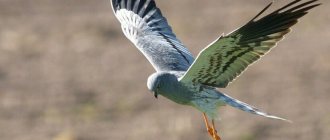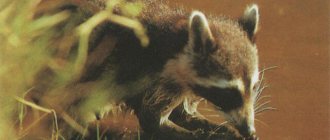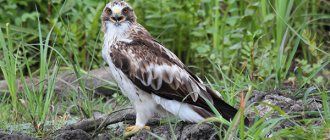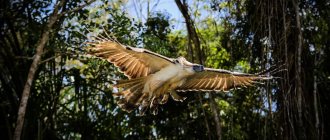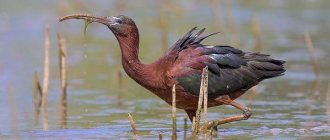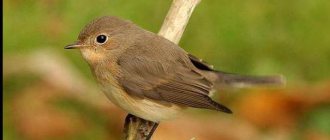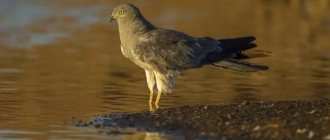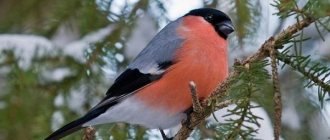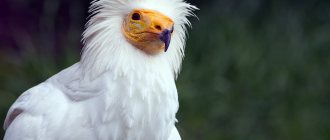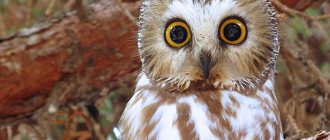| Latin name: | Aquila heliaca |
| English name: | To be confirmed |
| Kingdom: | Animals |
| Type: | Chordata |
| Class: | Birds |
| Squad: | Accipitridae |
| Family: | Accipitridae |
| Genus: | Eagles |
| Body length: | 72–84 cm |
| Wing length: | To be confirmed |
| Wingspan: | 180–215 cm |
| Weight: | 2400–4500 g |
External signs
Externally, the imperial eagle resembles a golden eagle, being smaller in size. This is a large representative of the hawk family with wide powerful wings and a long straight tail. The weight of birds ranges from 2.5 to 4.5 kg, and the total body length can reach 85 cm.
The main color of their plumage is dark brown, almost black. The neck area is light; here the feathers have a straw tint. You can often see white spots, so-called epaulets, on the shoulders of burial grounds. Sexually mature males and females are virtually indistinguishable in appearance, but they don adult attire only in the sixth or seventh year of life. The cere and legs are yellow, but the toenails are bluish-black.
The voice of the burial ground is a rough sound, reminiscent of both a goose cackling and a dog barking.
Main characteristics
The imperial eagle is a very large eagle, similar in build and coloration to the golden eagle, but slightly smaller. The body length is approximately 70–80 cm, the wingspan varies from 175 to 215 cm, and the male weighs 2.5–4.5 kg. Females are larger than males. The eagle is a majestic bird that has a loud, guttural voice and belongs to the hawk family. This species has powerful claws, a curved beak, and excellently developed muscles.
Eagles have strong necks and rather long legs; they are consummate predators. They have well-developed so-called feather “pants” on their legs. The birds have wide wings, their length is slightly more than 50 cm. Eagles fly quite high and without any problems track down their prey thanks to their excellent eyesight. They fly in pairs or alone. The sense of smell is practically not developed. They become sexually mature at four to five years of age.
Common types of burial ground
Spanish Imperial Eagle (Aquila adalberti)
The species is endemic to the Iberian Peninsula, and is distributed only in the south and west of Spain, Portugal, and the bird is occasionally found in northern Morocco.
The body length of the Spanish Imperial Eagle reaches 80 cm, the wingspan is 1.9-2.2 m. The weight of an adult bird is from 2.8 to 3.5 kg. The plumage color is mainly dark brown. The neck on the back is light, contrasting with the rest of the plumage. There are white spots on the shoulders and wings at the back, which is a distinctive feature from the Imperial Eagle.
Nesting
The bird moves freely on the ground, but this phenomenon is quite rare, and can only be seen in the early morning, when the lack of rising air currents prevents the imperial bird from taking off. Often the need to land is due to the fact that there is a nest in close proximity. In fact, the Imperial Eagle is an eagle that prefers desert steppe and forest-steppe zones for nesting, which could be used for several decades.
A couple who has chosen a place for themselves will simply improve the nest so that the chicks feel comfortable. Nests can be located both on the ground, among the branches of small growing bushes, and in trees. However, nesting at heights is associated with a certain risk, since birds constantly bring new fastening branches, and the tops of the trees simply cannot withstand the increasing weight and may break.
Nutrition and feeding behavior
The Imperial Eagle feeds mainly on small and medium-sized mammals: ground squirrels, mice and voles, hamsters, as well as young hares and marmots; It also catches birds, most often grouse and corvids. Carrion plays a significant role in the diet of the Imperial Eagle, especially in early spring, when rodents have not yet emerged from their burrows after hibernation, and birds have not returned from wintering.
At this time, eagles specially fly around those places where they can find the corpses of wild or domestic animals that have died over the winter. The average daily food requirement of the Imperial Eagle is 400-600 g, but it can eat more than 1 kg at a time and be content with 200 g.
- Scolopendra
- 32 facts about tigers
- Weasel
- Whale shark
- 34 facts about raccoons
- Maned wolf
The Imperial Eagle usually grabs prey from the surface of the ground, and birds - on takeoff. The eagle does not hunt flying birds. In search of prey, it soars in the sky for a long time or keeps watch from perches, including old burial mounds.
Reproduction, nesting
The mating season for eagles begins in early spring. At this time, males begin to fly demonstratively, trying to interest the female. The Imperial Eagle bird is very talkative when attracting the attention of a female. Males use the famous “kra-krav” to invite females on a date. In this way they express admiration for individuals of the opposite sex.
Eagles are monogamous birds. During flights and wintering, pairs stay together. Once the eagles find a suitable nest site, they begin construction.
Nests are created on large old trees, very rarely on bushes. The nest consists of tree branches, the inside is lined with straw, moss, grass, and dried manure is certainly used. The nest reaches one meter in diameter. The site on which it is located has been used by eagles for several years. The female and male actively arrange the nest, but the leading role belongs to the female. Burial grounds are wonderful parents.
With an interval of two days, the female lays eggs, so the chicks are born in turn. The incubation period lasts approximately forty-three days. The clutch contains from one to three eggs of a dirty white color with small brownish spots. Most of the time the eggs are incubated by the female, while the male forages for food. He can circle in the sky for several hours, looking for a victim. As soon as the eagle has discovered its prey, it quickly kills it with its powerful beak.
The chicks have snow-white downy outfits and a grayish iris. In rare cases, the youngest chick dies, unable to withstand competition with its older brothers. In the first week after birth, the female warms and protects the defenseless chicks. After about 9-11 weeks, the chicks begin to fly out of the nest, but continue to stay close to their parents for a long time.
Population
At the moment, in nature it is very rare to find the optimal combination of nesting conditions suitable for the burial ground and sufficient food supplies. Deforestation, fires, economic development of territories, the use of pesticides, poaching - all this has an extremely negative impact on the population of this species. In addition, these birds are hunted for the purpose of making stuffed animals. This is a fairly profitable business, especially when it comes to supplies abroad. Young and inexperienced burial grounds workers often die from electric shock on power line poles. Some become victims of poachers on migration routes.
In general, birds adapt well to life in captivity. Since 1990, a nursery for breeding imperial eagles has been operating in the Galichya Gora Nature Reserve. The species is protected in many Russian nature reserves and national parks.
Bird distribution
— Advertising —
The Imperial Eagle is a rare bird with a small population. It is distributed in the desert, steppe, forest-steppe and forest zones of Eurasia. The total number of the European population does not exceed 950 pairs; more than half nest in the southwestern territories of Russia.
Depending on its habitat, the Imperial Eagle is either a migratory or partially migratory species. Adult inhabitants of Central Europe, the Balkan Peninsula, Asia Minor and the Caucasus lead a sedentary lifestyle, and young animals from these regions fly south for the winter. Birds of the eastern range winter a little south of their usual habitats. Other populations migrate to Turkey, Israel, Egypt, Saudi Arabia, India, Iran, Pakistan, Iraq, Laos, and Vietnam.
Imperial Eagles fly south starting in mid-September, and return to their native lands in early April.
Eagle at home
If you decide to buy an eagle, then it is better to purchase chicks, since an adult is accustomed to freedom and will not be able to adapt to life in captivity. In order for the chick to grow healthy and strong, it must be fed properly. The young Imperial Eagle prefers lean meat in its diet, with the exception of pork. In order to teach a chick to fly, you need to work with it for one hour a day. A domesticated eagle cannot be released into the wild, as it will die. The eagle is a proud, noble and majestic bird. It is depicted on the coat of arms of St. Petersburg as a symbol reflecting the power and greatness of the city.
Voice
In comparison with its closest relative, the golden eagle, the imperial eagle, the photo of which is located below, is a rather noisy bird. Most often, its deep, rough voice is heard at the beginning of the breeding season at a distance of up to a kilometer from the bird. The duration of the cry, vaguely reminiscent of a dog barking, is sometimes up to 10 syllables.
If the burial ground detects a stranger on its territory, located in the immediate vicinity of the nest, it emits a warning cry, without paying attention to which, an individual who dares to approach the nest may be seriously harmed.
Interesting Facts
- Pairs of Imperial Eagles annually repair their nests by adding new branches to them. The weight of the nest is constantly growing, and the branch on which it is attached does not always withstand this load, so it can break.
- In some European countries, despite official bans, people still fight against foxes and wolves using strychnine baits, which kill many species of animals, including burial grounds.
- Several generations of imperial eagles can use one nest for several decades and even centuries.
- Despite its rather large size, the Imperial Eagle also hunts small animals, such as frogs, lizards and insects.
Video
Habitat
You can meet the imperial eagle in northern Africa, as well as on the Eurasian continent from Spain to Transbaikalia. In Russian latitudes, it has become widespread in southern Siberia and the European strip.
They prefer to inhabit mixed forests, as well as forest-steppes. Dry forests with a predominant number of tall pines, which are surrounded by open areas, are chosen as nesting sites. They can also live in birch and oak groves.
WHAT DOES IT EAT?
Like other eagles, the Imperial Eagle feeds mainly on live prey, but does not disdain carrion, which at certain times can become its main food - this happens in harsh winters, when live prey is difficult to find.
The burial eagle looks out for its prey, sitting on a high tree, and when it spots it, it pounces on top of it. After a short pursuit, the eagle usually overtakes the victim and digs into it with its strong and razor-sharp talons. In most of its range, the main diet of the Imperial Eagle consists of hares, hamsters, ground squirrels, rabbits and other small rodents. This bird of prey is capable of catching large prey weighing up to 5 kg. It also preys on birds such as young ducks, geese, crows and even flamingos.
The Spanish subspecies, found in the mountains of central and southern Spain, feeds mainly on rabbits. Imperial Eagles not only live, but often hunt in pairs: one bird flushes the game and drives it towards the other, which stands ready. After the pair manages to catch the prey, they eat it together.
Taxonomy
Russian name
: Eagle-Boneyard
Latin name
—Aquila heliaca
Squad
- Falconiformes
Family
- hawks
At the beginning of the 19th century, it was simply called an eagle in Russia. The name “burial ground” appeared later, when active study of the nature of the steppes of the Aral Sea region and Kazakhstan began. A large, beautiful bird of prey was often seen sitting on the tops of ancient burials - mausoleums and mounds. Then this gloomy name was assigned to the eagle - “burial ground”. Recently, an opinion has emerged that it would be a good idea to rename the eagle, for example, solar (direct translation from Latin) or imperial (as it is called in many languages, for example, imperial eagle in English).
Conservation status
The Imperial Eagle is a rare species; it is included in the IUCN Red Book, as well as in the Red Books of Russia, Kazakhstan and Azerbaijan.
The IUCN Red List also separately includes the Spanish burial ground, which is found only on the Iberian Peninsula. Its range is isolated from the main area of distribution, and the current number does not exceed 500 pairs. Currently, many ornithologists distinguish the Spanish Imperial Eagle as an independent species, Aquila adalberti, which received its name in honor of Prince Adalbert of Bavaria.
FLIGHTS
With the onset of winter, most imperial eagles fly from Europe to Asia or North Africa, the Arabian Peninsula and the Middle East to Iran.
The colder the winter, the farther the birds fly. Then the youngest of them fly away. During a long flight, the imperial eagle saves energy and uses the large surface of its wings for gliding in air currents.
Having risen to a sufficiently high altitude, it smoothly descends down to the next air flow, which lifts the bird up again. Imperial Eagles do not risk flying over large expanses of water, since there are no warm air currents in these places and the birds have to expend a lot of effort.
Literature
- S. Cramp, K. E. L. Simmons
Vol. II - Hawks to Bustards // The Birds of the Western Palaearctic. - Oxford University Press, 1980. - 695 p. — ISBN 0-19-857505-X - Benny Gensbøl
Collins Birds of Prey. - UK: HarperCollins, 2007. - 416 p. — ISBN 0007248148 - J. M. Thiollay.
Family Accipitridae (Hawks and Eagles) in del Hoyo, J., Elliott, A., & Sargatal, J., eds. Vol. 2 New World Vultures to Guineafowl. // Handbook of the birds of the world. - Barcelona: Lynx Editions, 1994. - ISBN 84-87334-15-6 - G. Dementyev, N. Gladkov.
Birds of the Soviet Union. - Soviet science, 1951. - T. 1. - I. V. Karyakin.
Feathered predators of the Ural region. Falconiformes, Owls (Strigiformes). - Perm: TsPI SOZH Ural/SoES, 1998. - 483 p. — ISBN 5-88587-091-8 - V.K. Ryabitsev.
Birds of the Urals, the Urals and Western Siberia: A reference guide. - Ekaterinburg: Ural University Publishing House, 2001. - 608 p. — ISBN 5-7525-0825-8 - V.V. Ryabtsev.
Eagles of Baikal. - Irkutsk: AEM "Taltsy", 2000. - 128 p. - L. S. Stepanyan.
Abstract of the ornithological fauna of Russia and adjacent territories. - Moscow: Akademkniga, 2003. - 808 p. — ISBN 5-94628-093-7
Notes
- Five-language dictionary of animal names. Birds. -page 40
- Aquila heliaca Savigny, 1809 - Burial ground. Vertebrates of Russia
. Institute of Ecology and Evolution named after A. N. Severtsov RAS. - V.V.
Ryabtsev Eagles of Baikal. - Irkutsk: AEM "Taltsy", 2000. - VC.
Ryabitsev Birds of the Urals, the Urals and Western Siberia: A Guide. - Ekaterinburg: Ural University Publishing House, 2001. - P. 125-126. - Benny Gensbøl
Collins Birds of Prey. - UK: HarperCollins, 2007. - pp. 324-328. - G. Dementyev, N. Gladkov
Birds of the Soviet Union. - Soviet science, 1951. - T. 1. - S. Cramp, K. E. L. Simmons
Vol. II - Hawks to Bustards // The Birds of the Western Palaearctic. - Oxford University Press, 1980. - 695 p. — ISBN 0-19-857505-X - V.P.
Belik Some elements of the ethology and ecology of the Imperial Eagle in Eastern Europe. Novosibirsk State University. - Benny Gensbøl
Collins Birds of Prey. - UK: HarperCollins, 2007. - pp. 148-151. - L. S. Stepanyan
Abstract of the ornithological fauna of Russia and adjacent territories. - Moscow: Akademkniga, 2003. - P. 98. - V.P.
Belik, V.M. Galushin Population structure of the range of the Imperial Eagle in Northern Eurasia. Novosibirsk State University. - Eastern Imperial Eagle Aquila heliaca. BirdLife International.
- J. M. Thiollay.
Family Accipitridae (Hawks and Eagles) in del Hoyo, J., Elliott, A., & Sargatal, J., eds. Vol. 2 New World Vultures to Guineafowl. // Handbook of the birds of the world. — Barcelona: Lynx Editions, 1994. - I. Karyakin
Cemetery (Aquila heliaca).
Species Sketches
. Server for environmental organizations of Southern Siberia. - Aquila heliaca burial ground. The Red Book of Russia
. BioDat. - The Imperial Eagle leaves Olkhon // Discover Baikal
: website.
The Mystery of the Eggshell
Thanks to the support of the Presidential Grants Fund, this season volunteers from all over Russia are working at the cemetery in Opushki.
“According to the terms of the grant, we had to accept 40 people,” says Anastasia Stoyanova, director of the Millennium Heritage charity foundation. — But much more applications were received - 120. As a result, we selected 45 volunteers.
A resident of Yalta opened a home museum of Jurassic fossils
For some, history is just a hobby, for others, like for Serpukhov graduate Daria Trushina, it is a future profession.
“I graduated from school this year and will enter the history department,” the girl said. “I decided to first get acquainted with this profession in practice. Everything is as I expected. The work did not disappoint me.
Life in the camp begins at six o'clock in the morning. Breakfast - and run to the excavation site, have time to work before the heat gets hot. All beginners are given a shovel to start with. They then work mostly with a trowel, brush or broom, or sift through the soil looking for small parts. The excavations are led by five professional archaeologists.
Among the finds this season is a collection of various tableware, giving an idea of where and who made it. Red glaze plates come from Chersonesos. They were made by Greek potters. And the primitive black jugs are Scythian crafts. Glass glasses are a typical attribute of the ancient Germans. Nearby is a set of metal bells of different shapes. They are often found in women's and children's burials. And here is a mysterious object that resembles a bracelet. But the fact is that it was never put on either arm or leg, but lay next to the body of the deceased. Here is a completely unexpected find - an early Scythian buckle, made in a typical animal style.
The vault of the Tavrida cave was opened in Crimea
“When she got to the burial ground, she was already about 500 years old,” says Igor Khrapunov.
Among the burials in Opushki, about 50 horse graves were found. In fact, this is not uncommon for Crimea. Horses buried next to their owners have been found before, but here their poses are different. The animals lie on their stomachs, and their heads are placed on a special ledge.
“We found bird bones, eggshells, bones of sacrificial animals, as a rule, these were legs of lamb,” says Anastasia Stoyanova. — This year, paleozoologists will work with us, we hope they will provide additional information about this monument.
Poultry and eggs indicate that there was still a settlement somewhere nearby. Sooner or later, archaeologists will find him.
Help "RG"
The Millennium Heritage Foundation, whose specialists, together with Kazan Federal University, are exploring the Opushki burial ground, has existed for more than 20 years. During this time, professional historians implemented several major scientific and educational projects. Archaeologists explored the burial grounds of Dort-Leme, Orman, Neisatz, studied mounds along the Taurida route, published several scientific collections, organized a school of young archaeologists and popularized historical knowledge.
